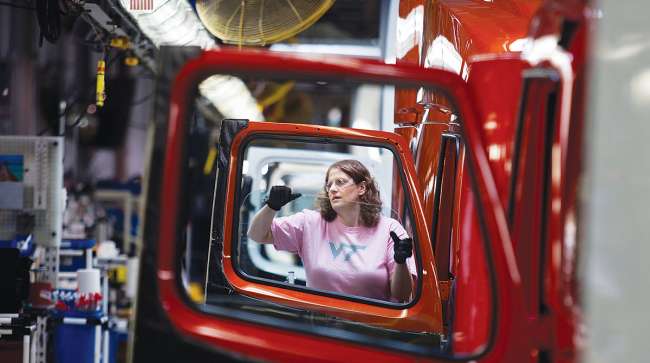Senior Reporter
December Class 8 Orders Drop as 2018 Annual Volume Sets Record

North American Class 8 orders for December were 21,300, falling sharply from a year earlier but about at replacement level as production slots remain scarce and full-year orders set an all-time record.
Orders fell 43% from 37,569 a year earlier, according to ACT Research Co., citing preliminary data supplied by truck makers.
For all of 2018, orders reached a record 490,100 — smashing the previous high of 390,000 in 2004. That compared with 265,409 for all of 2017 while 2016 orders totaled 186,628.
The December decline was inevitable given the record backlog truck makers already are handling, experts said.

Tam
“From our perspective, this was very much in line with expectations. The biggest reason is when we are sitting on a backlog north of 300,000 units, there’s just not capacity within the system to be able to facilitate much more demand than we have in place right now,” ACT Vice President Steve Tam said.
He said the total backlog reflects the 160,000 orders the year started with and the 140,000 it has increased with.
December’s preliminary orders do not include the number of order cancellations.
Tam said he has not heard any anecdotal comments reflecting a surge in second thoughts about previously placed orders.
“We are not hearing of a carrier crisis. Carriers are not abandoning their plans to acquire equipment,” he said.
But cautiousness has crept into the market.
Load One is a transportation and logistics company based in Taylor, Mich., with 70 company drivers and 345 owner-operators. It is only doing replacement orders in 2019, with deliveries scheduled mostly in the second half of the year when it found enough production slots.
“I am a little concerned about the market right now. With orders being so far out, I don’t like to have to guess the market that far out, especially with the ups and downs in the trade wars, the stock market and the House of Representatives changing hands now,” Load One CEO John Elliott said.
He added: “The economy is a very foggy crystal ball right now.”
But research firm FTR pegged preliminary orders at 21,000 — and noted they were becoming less important as a measure of demand.
“For the next, maybe, six months the order number is less important. It doesn’t matter as much because it is not going to give you a direction [of demand],” because there are already too many orders in the system, said Don Ake, FTR vice president of commercial vehicles.
“Month to month, what is going to be important are production and retail sales numbers,” Ake said.

Ake
Credit Suisse analyst Jamie Cook expects orders to fall in the months ahead.
“We expect orders in Q1 2019 to be in the 20,000 range, with Q2 in the 10,000-15,000 range,” she said.
With 2018’s surge in orders, “production levels are at the highest levels in over a decade,“ said Daimler Trucks North America CEO Roger Nielsen.
DTNA’s flagship Freightliner Cascadia Class 8 truck was introduced in 2007 and relaunched in 2017 and since then has garnered 145,000 orders, he said.
DTNA is the market leader in U.S. retail Class 8 sales.
“With full order boards and an overall still positive economic outlook, we are confident that 2019 will be another great year for America’s trucking industry, but we do expect some moderation in the second half of the year,” Nielsen said.
Another truck maker also had a positive outlook.
“We have a lot of confidence in the backlog and don’t believe we face massive cancellations,“ Troy Clarke, chairman and CEO of Navistar International Corp., said in a December fiscal year fourth-quarter earnings call.
Also, Clarke said the growing number of large fleet customers now ordering International trucks could weather a market downturn, which protects International’s growing market share.
In related news, Kenworth Truck Co., a unit of Paccar Inc., chose December to open its order board for its new W990 long-hood conventional Class 8.
The new model “leverages the 67-year evolution of the iconic W900 platform to provide Kenworth customers with a product that captures the pride, image, freedom and spirit of trucking; and continues Kenworth’s tradition of offering driver-focused trucks,” according to the company.
At the same time, there’s no guarantee that all of those 300,000 units in the industry’s backlog are going to get built, Tam said.
“Orders will possibly be canceled, and it will be dependent on what happens in the freight market and the general broader economy,” he said. “You could see a downside to this year and potentially 2020.”
ACT estimates North American replacement demand at 240,000 units.


